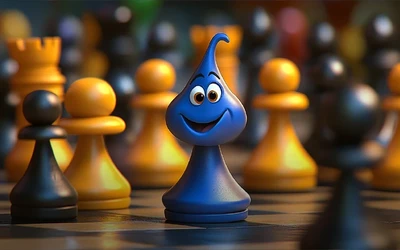
The Art of Punishing Mistakes!
Your Opponent Blundered. Now What?How many times has this happened to you? Your opponent makes a weird, dubious, or outright bad move. You knew in your gut it was a mistake, but you couldn't find the perfect way to capitalize. How often have you felt frustrated after letting your opponent back into a game they should have lost?
If this sounds familiar, you're not alone. It's one of the most common challenges for chess players at every level. The ability to convert an opponent's mistake into a concrete advantage is what separates good players from great ones.
The good news is, punishing mistakes isn't magic; it's a skill you can learn. In this post, I'll share a simple three-step thinking process to use every time your opponent gives you a gift.
Step 1: Diagnose - "Why is this move bad?"
Before you jump to attack, pause for a moment and ask yourself: What is the main weakness in my opponent's move? It’s not enough to feel that it’s bad; you need to identify the specific damage it has caused to their position. Did it:
- Weaken the king? (e.g., moving a pawn in front of their castled king).
- Leave a piece undefended? (A piece that is now "hanging" or can be attacked).
- Create a weak square? (A square their pawns can no longer control).
- Waste a tempo? (Moving the same piece multiple times for no good reason).
- Block their own development? (Putting a piece in the way of another).
Once you identify the core problem, your goal becomes clear. If they weakened their king, your plan is to attack the king.
Step 2: Plan - "How do I exploit this weakness?"
Now that you know the weakness, it's time to form a simple, direct plan to target it. Don't look for complex tactics just yet. Think strategically first.
- Example 1: Your opponent plays
...f6early in the game (like1. e4 e5 2. Nf3 f6?).- Diagnosis: This move dangerously weakens the king's position and opens the d1-h5 diagonal.
- Plan: My plan should be to open the center quickly to attack the weak king. I should aim to get a bishop on c4 or a queen to h5.

- Example 2: Your opponent brings their queen out way too early.
- Diagnosis: The queen will become a target for my developing pieces, costing my opponent time (tempo).
- Plan: I will develop my pieces (knights, bishops) while attacking the queen with each move. I'll gain free development while they're busy saving their queen.
The plan doesn't have to be a knockout punch. It's about building your advantage, step by step.
Step 3: Execute - "Find the precise move."
Now that you have a clear plan, it’s time for tactics and calculation. Start by looking for forcing moves (checks, captures, and threats). Is there a direct tactic that wins on the spot?
If there's no immediate win, look for the best move that serves the "plan" you made in Step 2. Find the move that increases the pressure on the weakness you identified.
A Golden Rule: Don't Rush! When your opponent blunders, it's easy to get excited and play the first "good" move you see. This is the exact moment to slow down. Take a deep breath, apply the three steps, and look for the best move, not just a good one.
Putting It All Together
Punishing mistakes is the journey of turning a "small edge" into a "winning position." Always remember the three steps:
- Diagnose: Why is the move bad?
- Plan: How will I exploit it?
- Execute: Calculate the tactics and find the most precise move.
Try this method in your next games. You'll find yourself playing with more confidence and precision when your opponents give you an opportunity. Good luck!
You may also like
 GM Avetik_ChessMood
GM Avetik_ChessMood10 Things to Give Up to Enjoy Chess Fully
Discover how embracing a lighter mindset can help you enjoy chess again and achieve better results. IM HelloItsDmitri
IM HelloItsDmitriConfirmation Bias - What is it, and how does it apply to chess?
Confirmation Bias is one of the more than a hundred cognitive biases that human brains are victims o… CM HGabor
CM HGabor